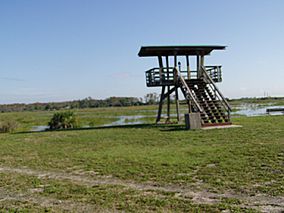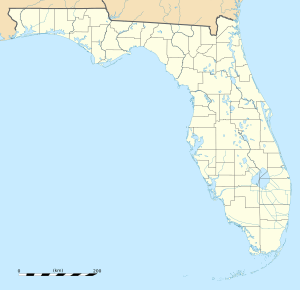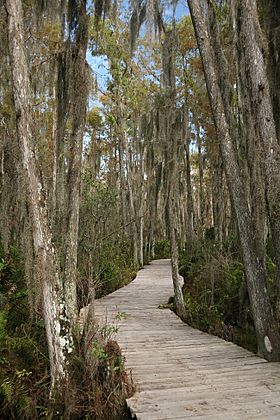Loxahatchee National Wildlife Refuge facts for kids
Quick facts for kids Arthur R. Marshall Loxahatchee National Wildlife Refuge |
|
|---|---|
|
IUCN Category IV (Habitat/Species Management Area)
|
|

Observation Platform overlooking the C-7 compartment on the Marsh Trail
|
|
| Location | Palm Beach County, Florida, United States |
| Nearest city | Boynton Beach, Florida |
| Area | 147,392 acres (596.47 km2) |
| Established | 1951 |
| Governing body | U.S. Fish and Wildlife Service |
| Website | Arthur R. Marshall Loxahatchee National Wildlife Refuge |
The Arthur R. Marshall Loxahatchee National Wildlife Refuge is a 147,392-acre (596.47 km2) wildlife sanctuary is located west of Boynton Beach, in Palm Beach County, Florida. It is also known as Water Conservation Area 1 (WCA-1). It includes the most northern remnant of the historic Everglades wetland ecosystem.
Bordering the Everglades Agricultural Area (EAA) to the west and the urban communities of Palm Beach County to the east, the conservation area contains over 145,000 acres of Everglades wetland habitat. Owned by the state, WCA-1 is currently managed by U.S. Fish and Wildlife Service and provides an area specified for recreation, wildlife population maintenance and habitat management and restoration.
Overview
The Arthur R. Marshall Loxahatchee National Wildlife Refuge is located seven miles west of the city of Boynton Beach in Palm Beach County, Florida. The refuge was established in 1951 under the authority of the Migratory Bird Conservation Act and is managed through a license agreement between the South Florida Water Management District and the U.S. Fish and Wildlife Service. In total, the refuge includes 145,800 acres of northern Everglades habitat. The refuge contains one of three water conservation areas (WCAs) in south Florida and is maintained to provide water storage and flood control, as well as habitat for native fish and wildlife populations. Water is regulated by a series of pumps, canals, water control structures, and levees built by the Army Corps of Engineers. These freshwater storage areas and part of the Everglades National Park are all that remain of the original Everglades.
Management Activities
According to the U.S. Fish and Wildlife Service, the refuge's management activities focus primarily on wetland habitat restoration, particularly through water quality and hydropattern improvement, and exotic plant control. A large portion of refuge management effort is spent controlling exotic and invasive plants and pursuing funding to eliminate these threats. The three most problematic exotic plant species on the refuge are melaleuca, Brazilian pepper, and Old World climbing fern (lygodium). The refuge is working together with many other federal agencies and state agencies regionally in South Florida to address these issues and restore Everglades habitat for the benefit of wildlife.
Features
Loxahatchee NWR is one of over 500 national wildlife refuges located throughout the United States and administered by the United States Fish and Wildlife Service. The refuge not only preserves and protects native wildlife, but also offers compatible public recreational and educational opportunities including walking trails, a canoe trail, bike trail, boat ramps, fishing platform, observation towers, butterfly garden, and a visitor center. It is home to American alligator, the endangered snail kite, coastal plain cooter and Florida softshell turtles, and as many as 257 species of birds. As such, it has been designated a 'gateway site' for the Great Florida Birding Trail.
Not quite all of the 147,392-acre (596.47 km2) refuge is Everglades marsh habitat. A 400-acre (1.6 km2) bald cypress swamp is the largest remaining remnant of a cypress strand that once separated the pine flatwoods in the east from the Everglades marshes. A boardwalk into the swamp gives the visitor a chance for an up-close swamp experience without getting their feet wet. Hurricane Wilma damaged the refuge in October 2005, and the administration building was condemned. The Lee Road fishing pier was damaged by Hurricane Irma and will remain closed until further notice.
- Conservation
Despite all of its treasures, the refuge is in serious danger of quickly becoming an exclusive haven for invasive plants, especially the broad-leaved paper bark (Melaleuca quinquenervia) and Old World climbing fern (Lygodium microphyllum), both rapidly growing non-native species, which are quickly overgrowing the native flora and are likely not compatible with the native wildlife.
Park Activities
The refuge allows multiple activities in the park such as, fishing, hunting, hiking and also offers guided tours. Fishing is allowed in only three areas of the refuge which are Hillsboro, Headquarters and the 20-mile bend. All fishermen must also carry a valid fishing license in the state of Florida. There are also over 16 different species of fish present within the refuge that are able to be caught. Hunting is allowed within the refuge to manage wildlife populations. It is one of 330 refuges open to the population for hunting. Waterfowl hunting is permitted in the late fall and early winter months. All hunters are required to possess a valid Florida State Hunting License and a Florida State Duck Stamp. Alligator hunting is only available by permit from the state of Florida. There are also numerous hiking trails throughout the refuge. One is a bald cypress swamp boardwalk that is located directly behind the visitor center. The others are accessible through the Lee Road parking lot. The refuge also offers guided tours throughout the year. They offer, canoe tours, night walks and tram tours by reservation only.
Images for kids
-
Zebra Longwing at the butterfly garden
-
American white ibis by the boardwalk







